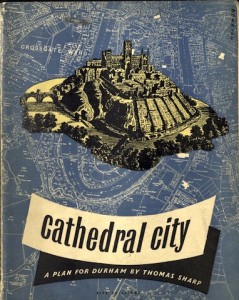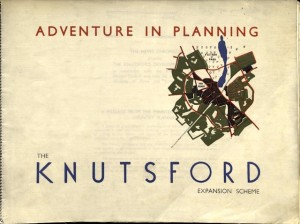Sharp, Thomas. Cathedral City: A Plan for Durham. London: Pub. for the Durham City Council by the Architectural Press, [1945].
 Thomas Sharp examines the challenges of and provides solutions for developing a plan for an historic city. The title of the work itself, Cathedral City, suggests that Sharp was keenly aware of the historic fabric and history of the city of Durham, England. He writes:
Thomas Sharp examines the challenges of and provides solutions for developing a plan for an historic city. The title of the work itself, Cathedral City, suggests that Sharp was keenly aware of the historic fabric and history of the city of Durham, England. He writes:
Even amongst those who use their eyes the mistake is often made of thinking of landscape as though it were an affair of trees and fields- nothing to do with the town. This is quite false. The error got currency from the fact that landscaping started in the parks of the great landowners. Actually the town landscape is just as interesting and important. When the ordinary street scene is thought of as a landscape surprising visual possibilities are opened up. In this case the Cathedral does what a cliff or mountain would do in a countryside, and the Georgian houses of the Bailey demonstrate once again what a magnificent foil they make for it. They are so to speak the stream that meanders at the base of the cliff. It can be seen at once how false is the popular idea of town planning as being the widening and straightening of streets and the “opening up” of historic buildings. The illustrations in this book have been chosen partly to demonstrate that Durham provides potentially the most dramatic urban landscape in England. (pg. 85)
Knutsford Urban District Council and the Ministry of Housing and Local Government, Great Britain. Adventure in Planning: The Knutsford Expansion Scheme. London[?], [1946].

I am unfamiliar with Knutsford, England, but then I have not read Cranford either. Thus, it was not my familiarity with the town itself that attracted me to the work but rather the presentation of the plan. The tiny spiral of the binding made me pull the book off the shelf. This plan, however, provides an interesting comparison to that of Durham, as it faced a different set of challenges. Despite the different challenges, the authors seem to be equally concerned with the relationship between the built environment and landscape. According to the authors:
Three maxims have been kept constantly in front of them by the five expert architect-planner and the committee who have consulted with them on the Knutsford Plan- that in a town, as in a nation, freedom must be balanced with the responsibility, work with leisure, and life in the home with a sense of good community….
The Master Plan for Knutsford, therefore, sets out deliberately to attack the notion that bricks and mortar mean either confinement of the individual spirit or dreariness and meanness in physical shape. The idea has been to show how the freedom and grace which are the essence of the surrounding country can be induced to flow through the town, and, at the same time to demonstrate how landscape well handled enhances urban architectural dignity and beauty, to produce a result that is urbane in the very truest sense of the word. (Knutsford: The Master Plan)
